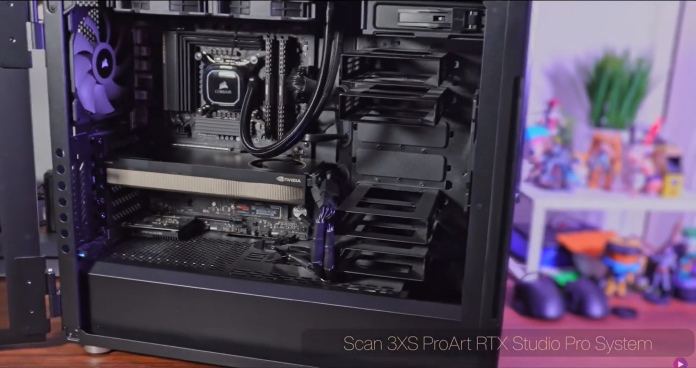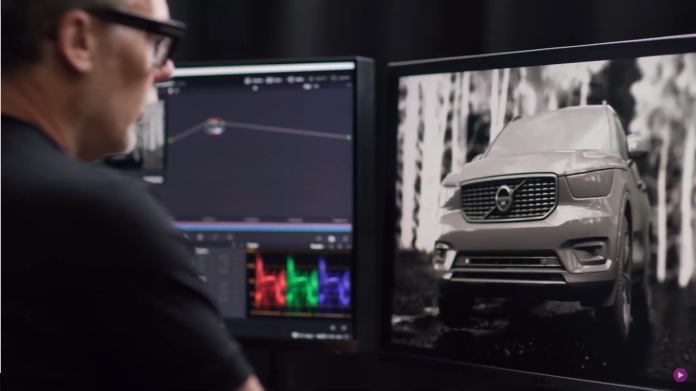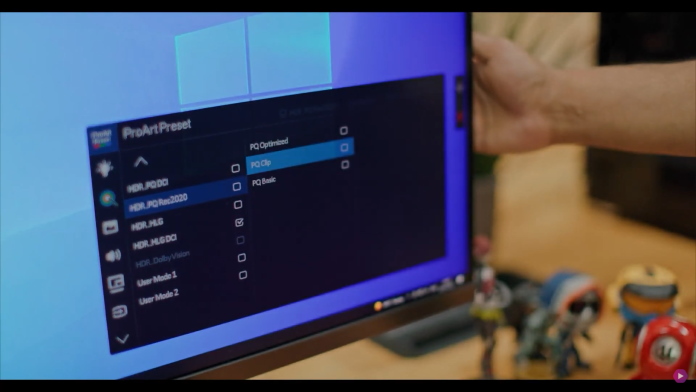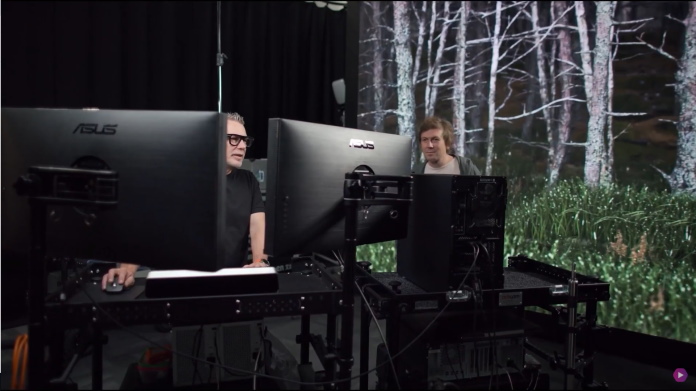For creative professionals, the limiting factor in their work has always been time. Sometimes it’s the time that it takes to render out a project. Sometimes it’s the time spent in the cycle of editing proxies, checking the render, and editing the proxies all over again to address unexpected problems. Sometimes it’s the time it takes to color grade a project for a range of viewer scenarios. With their extensive experience in directing, filmmaking, and game production, creators HaZ Dulull and Brett Danton know very well how these factors used to hinder their workflow. But all of that changed when they upgraded their creative workstation setups.
Recently, both sat down for a conversation with Scan Pro Video to talk about their new 3XS ProArt Studio workstations and ProArt Display PA32UCG monitors and how this hardware eliminated many roadblocks in their creative process. If you’re looking for a workstation setup that optimizes your post production and virtual production workflows, HaZ and Brett offer invaluable advice and practical tips in this podcast, and it’s worth your time to watch it in full.
Making a desktop PC their main creative workstation
Both creators have impeccable credentials and extensive experience. The co-founder of HaZimation, a micro-studio that develops and produces feature films, TV, and video games, HaZ is currently working on multiple projects in Unreal Engine. The demands of these projects led him to change the PC platform mid-production—a tough decision to make, but one that paid off for his team.
As a director on the move, he used laptops for editing, but the need for expandability and raw processing power drew him into using a desktop PC instead. He explained, “When you’re running real-time game engines pumping our 4K imagery, and all in real-time, laptops can heat up. So that’s why I made the move to a desktop. We have so much cooling power in that desktop, and we’re able to expand super-quick, and at the same time we’re making a video game.”
Over the last two decades, Brett Danton has established himself as a highly successful commercial photographer and motion director. Like HaZ, Brett also found himself making an unexpected move from Mac to PC. “I was a complete visual person coming from a Mac background and then jumping into things like Unreal Engine and Omniverse. I had to run a PC, and I thought it was going to be something where I was tearing my hair out,” he said. As it turned out, his worries were unfounded. “To be honest with you, it’s actually been a really interesting development for me. I’ve actually found it quite a painless swap-over, so much so that I’ve even moved my editing environment.”
Struggles with last-gen workflows
Not that long ago, the ability to work in real-time in 4K for animation, video editing, and 3D work was out of reach for most creators. Even professionals like Brett and HaZ had to find workarounds for the limitations of their hardware.
“We’d go off and shoot 6K raw, then we’d make proxies, we’d edit in the proxies, and then we’d have to re-link back to the original files. That’s where you got the issues,” Brett explained. “It always used to be something that would break in that process. A speed ramp didn’t happen, or a zoom or a reframe, and that’s the thing that used to always cause us headaches.”
Even further, last-gen hardware required considerable time for every render. “I’ve set an alarm to go off at three o’clock in the morning many times to run downstairs and set up the next render,” Brett said with a laugh. “I think the longest I ever had, we had 27 days of rendering on one job.”
HaZ also had to go to extremes to accommodate lengthy render times. “In the past, with CG and VFX, we would have a render wrangler, we would call that person, who would be working usually at night, so they’ll start at 10pm and finish at like 8am. And they just watched renders and triaged the renders.”
The power to edit in real-time
For both Brett and HaZ, their new ASUS-powered 3XS creative workstations have given them new levels of visibility and control over their projects. The capabilities of his new workstation have truly revolutionized Brett’s process. “I was literally saying to somebody after this last project we did, ‘I just had running in Resolve on this system a nine-camera feed—multitrack—and I was playing back in real-time with nine 6K raw camera feeds. That’s a massive amount of data.” Working in real-time with the raw files lets Brett shake off the problems of his previous setups. “Working inside a raw workflow, I’m not having to reconform anything.”

HaZ is also flexing the muscles of his PC. “I bring my EXRs, and I do the linear to sRGB conversion so I have my color space in there, I throw some grades in there, and I even throw some effects in there like Fusion effects, and I’m playing them back. Sometimes there is a slight frame lag with processing 4K EXRs with effects in realtime, but it’s enough for me to still work in a way that I’m not having to render a QuickTime out and then bring that back in.”
The expandability and connectivity your creative workstation needs
Exceptional processing power from both the CPU and GPU is only one part of what’s made the ASUS ProArt workstations by 3XS Systems so effective for HaZ and Brett. The ProArt motherboards in these systems deliver the comprehensive connectivity these creators need—and make no mistake, they need a lot. Brett detailed the fleet of displays and peripherals that he keeps connected to his workstation: “I have three to four displays plugged into the back of the system all working in HDR. I’ll have six or seven RAID 5s hanging off it. I’ll have control surfaces plugged into it. I’ve got a Blackmagic box hanging off it. I’ve got speakers hanging off. I’ve got a Dolby 5.1 system hanging off it. So in terms of stuff that I’ve got plugged into it, it’s phenomenal what it’s powering.”

Expandability is also crucial for these creative professionals. HaZ laid out his needs clearly: “I need a lot of drive space. I need SSDs, and I can’t be dealing with other types of drives. I need to be able to expand constantly because I don’t want to buy a machine that’s just going to be used for one project.”
Brett also highlighted the importance of storage in a modern creative workstation. “We’ve got to the point where these workflows run so well on a desktop that your main limiting factor is actually your storage. As long as you’ve got storage that’s fast enough, there’s nothing stopping you working with 4K EXRs or nine streams of 6K footage.”
Accurate and accessible ProArt Displays streamline your workflow
Fast workstations with powerful CPUs and GPUs, extensive connectivity, and room for fast and large storage arrays have empowered HaZ and Brett to conduct post-production and virtual production workflows in real-time. Their displays have an equally important role in enabling them to work efficiently.
“When you’re working in animation and very visually driven things, you want to make sure that whatever you deliver is going to be seen correctly,” HaZ explained. “Color space and calibration have always been, even when I was in visual effects, the thing that’s bane of our life. The shot looks great, but someone gives a note that it looks a bit milky here or the blacks don’t look right.”

The ProArt Display PA32UCG helps HaZ avoid these time-consuming problems. “It comes with this calibration system and it’s so simple. I can just calibrate my monitor, but I can calibrate it based on the output of the deliverables. The video game would have a slightly different calibration as opposed to my animated film. I can create profiles and save them in the monitor. That’s the beautiful thing about it. I can just flick between the various profiles.”
As a VESA DisplayHDR 1400-certified monitor, the PA32UCG also sets up these creators for easy HDR grading. For HaZ, that saves him considerable time and expense. “Before we go into the main grading facility to do an actual proper HDR, I can actually see the HDR version myself here before going to the big place so I can make decisions as a filmmaker when it comes to color and tone and scene setting on that monitor. When I go to the facility, I’m not booking a week of grade time. I’m booking a couple of days. That’s huge.”

Brett uses his three PA32UCG monitors all the way from the set to editing. “This is definitely the best that I’ve used to date,” he declared, “so much so that the last shoot we took the monitors with us. They go on to our computer cart for the DIT to use. It’s giving me a complete workflow from my desktop to studio to being on set.”
Optimize your creative workflow with ProArt hardware
Whether you’re a seasoned pro like Brett and Haz or a budding creative just starting on your journey, ASUS ProArt components, PCs, and displays offer the performance and features you need for a creative workstation. ProArt motherboards built on the latest cutting-edge chipsets from Intel and AMD are ready to serve as the foundation of your next DIY PC workstation. For an out-of-the-box solution, consider a workstation from our partners at Scan Pro, or take a look at our wide range of creator-focused laptops. Finally, there’s a ProArt display for every user and every budget. Don’t let last-gen hardware continue to add delay and frustration to your creative workflow—find the control and efficiency you need with ProArt hardware.

